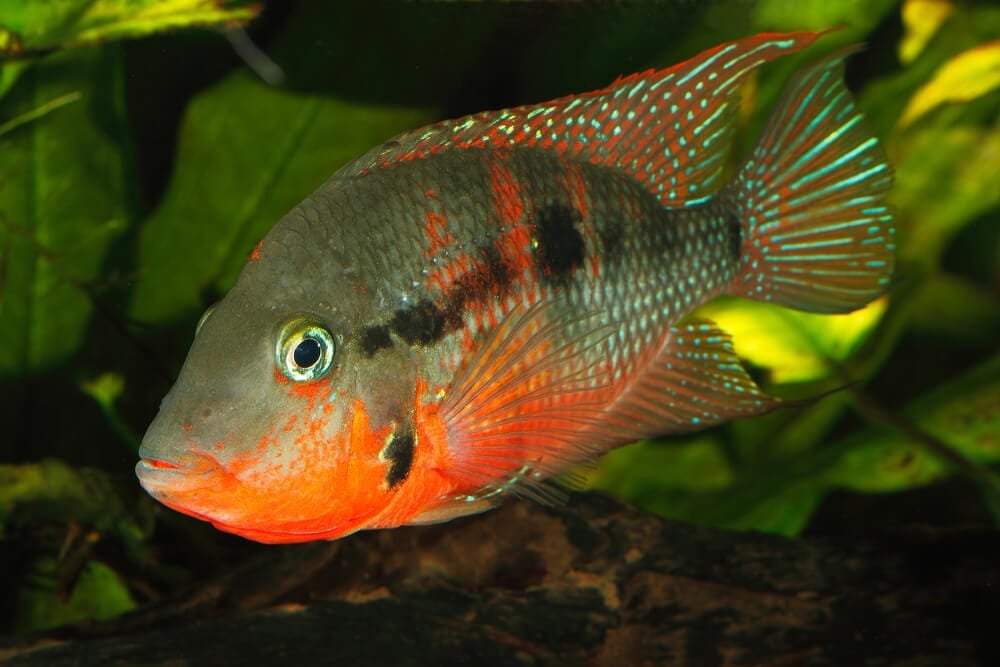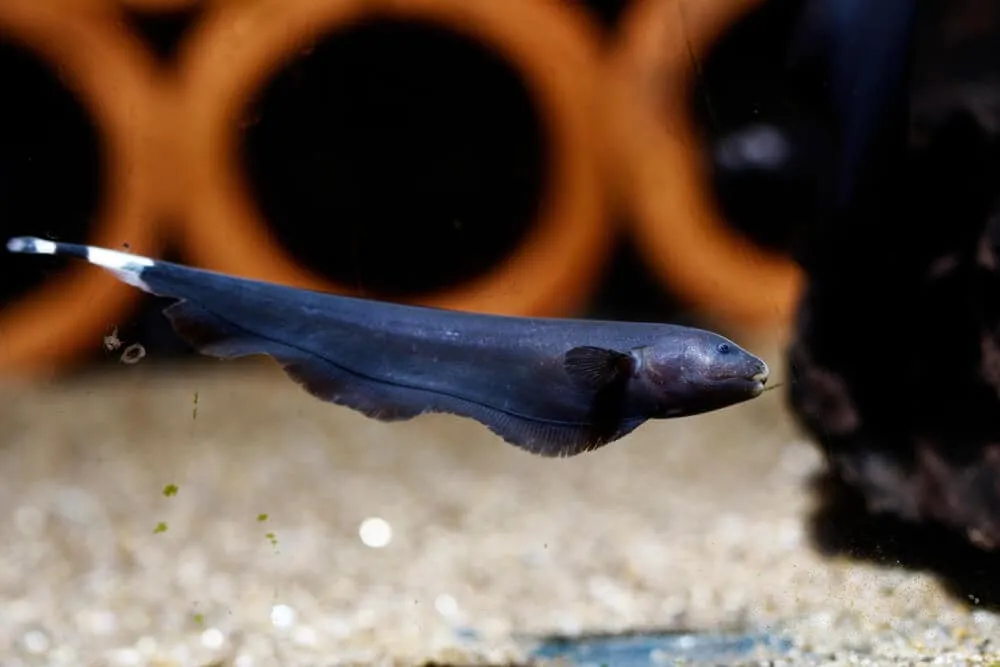Top 8 Of The Best Firemouth Cichlid Tank Mates
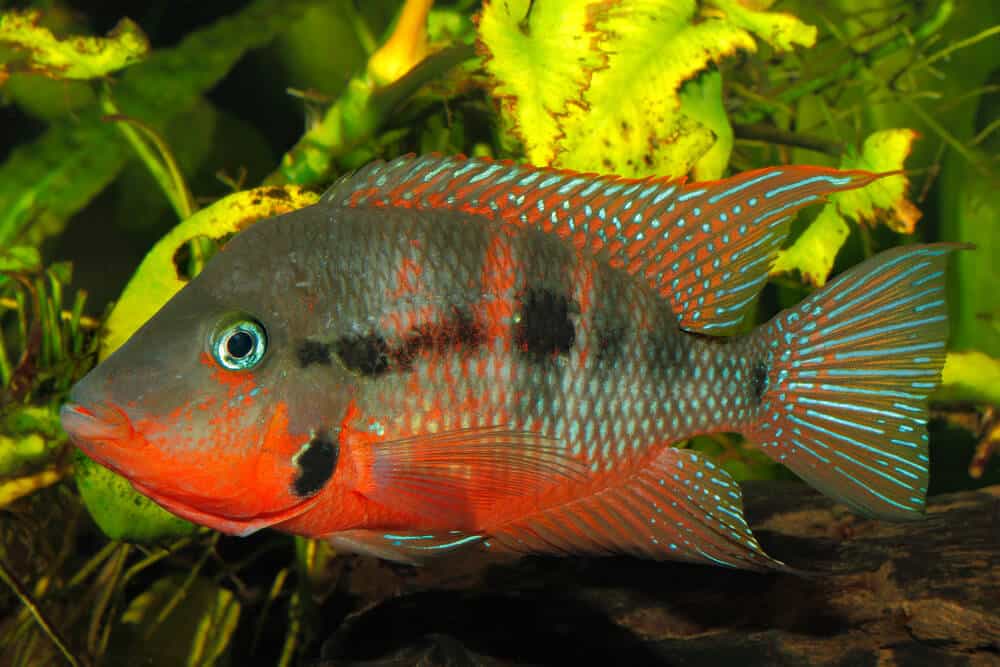
What could be the best Firemouth Cichlid tank mates when the species is known to be beautiful but semi-aggressive? The species is popular with aquarium hobbyists despite its feisty personality.
They are vibrant freshwater fish that adds color to your tank; you will enjoy seeing them swim and move the colors around. While they require some special treatment, this fish is not high-maintenance.
However, since they are somehow aggressive, you cannot add other fish of similar nature. Take note the Firemouths won’t start trouble unless provoked. So their best tank mates are fish similar in size and aren’t aggressive.
The Best Firemouth Cichlid Tank Mates
You have plenty of options for the other fish you can add as tank mates for your Firemouths for as long as you have a large enough tank.
You only have to make sure that the fish you will add are not aggressive and are similar in size to the Firemouth. The bigger ones might stress them out, and tank mates that are too small might get bullied.
Here are the recommended tank mates for your Firemouth Cichlid:
1. Rummy Nose Tetra
Size: 5 inches
Minimum Tank Size: 20 to 30 gallons
Water Temperature Range: 73°F to 80°F
Diet: Herbivore
Care Requirements: Easy
Temperament: Peaceful
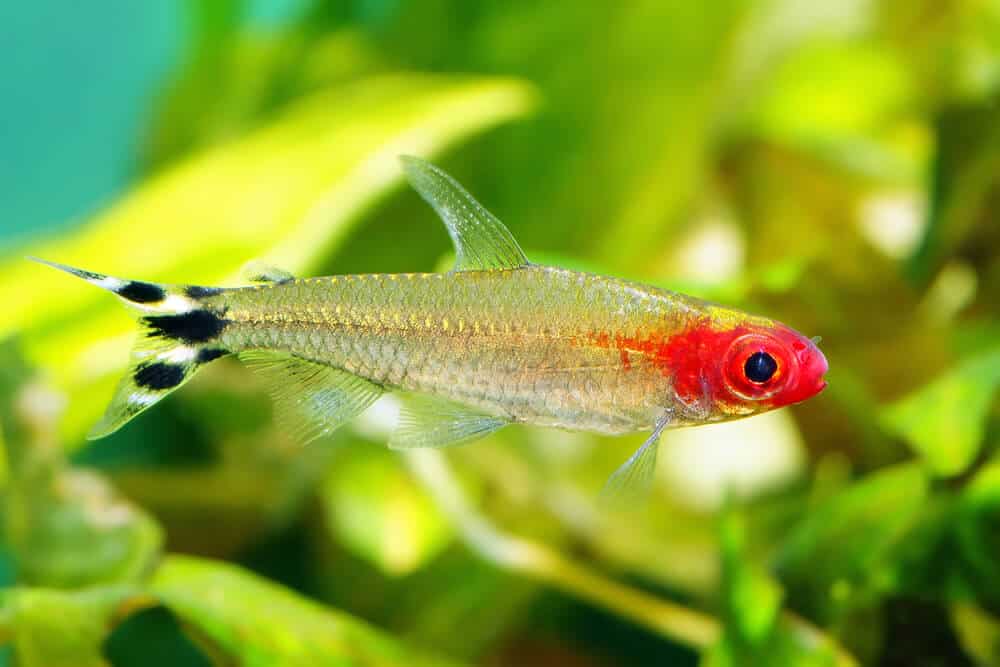
The Rummy Nose Tetra is one of the most popular tetras in the hobby community. It’s hard to find a breeder or store that doesn’t have at least one of these fish on hand.
This little creature is easy to care for, and it’s gratifying to see them grow into a full-grown adult. It is a moderate-sized fish that can grow up to two inches in length.
The fish has a body shape that looks like it has a rumpled nose. It has three stripes running down its body, with one line extending from the head to the base of its tail fin.
The coloration is silver with black spots on top of its body and faint yellow lines running along each side of its body. The fins are also colored this way, with a green and black band running across the back fin, and the other two fins are also colored in a similar fashion.
Rummy Nose Tetras are very social fish, so it’s recommended that you keep at least two in your tank at all times.
They’re active swimmers that enjoy swimming around the bottom of your tank with other Firemouth Cichlid tank mates. This makes them great for keeping with other similar fish.
2. Clown Pleco
Size: 3 inches
Minimum Tank Size: 20 gallons
Water Temperature Range: 73°F to 82°F
Diet: Omnivorous
Care Requirements: Easy
Temperament: Peaceful
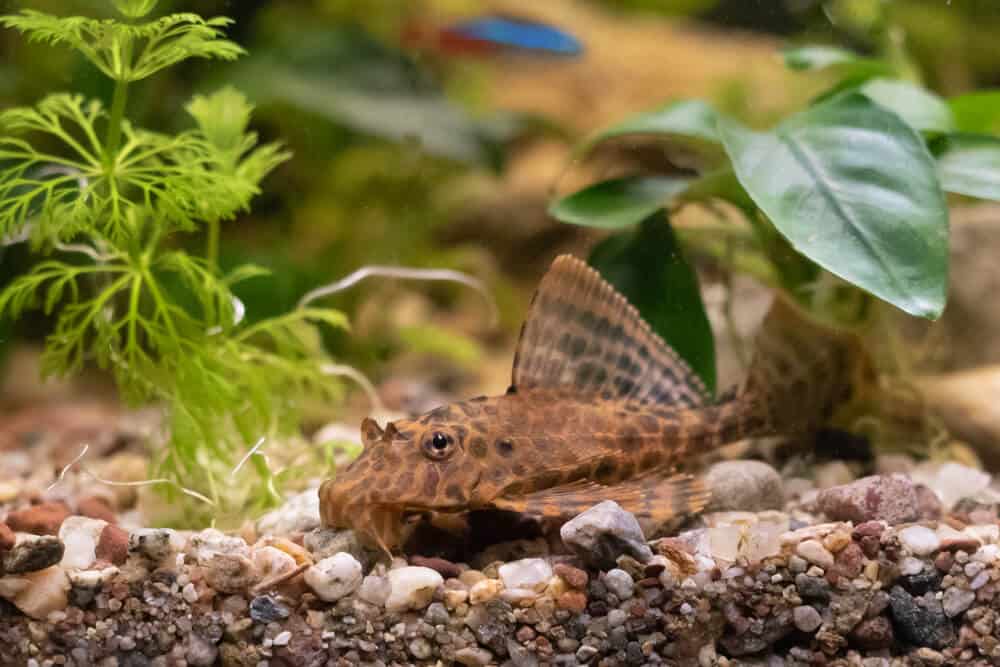
The Clown Pleco is a slow-moving fish that can grow up to three inches long. It has black and orange spots on its body though there can be variations depending on where it is kept.
It has a long, thin body with small fins on both sides of its body. These fins help with movement in the water and feed on algae, driftwood, or plants.
It also has two barbels or whiskers hanging from its mouth that it uses for feeding and cleaning itself.
Good water quality, including pH and hardness, is vital because Clown Pleco does not tolerate poor water conditions well. They also need good nutrition for optimal growth, which can be supplemented with protein-rich foods such as bloodworms and Mysis shrimp.
The Clown Pleco is peaceful and can be kept with other fish varieties if compatible. They will become aggressive when two males live together, but once they settle into your tank and get used to each other’s presence, there shouldn’t be any problems.
3. Cory Catfish
Size: 3 inches
Minimum Tank Size: 20 to 30 gallons
Water Temperature Range: 70°F to 80°F
Diet: Omnivorous
Care Requirements: Easy
Temperament: Peaceful
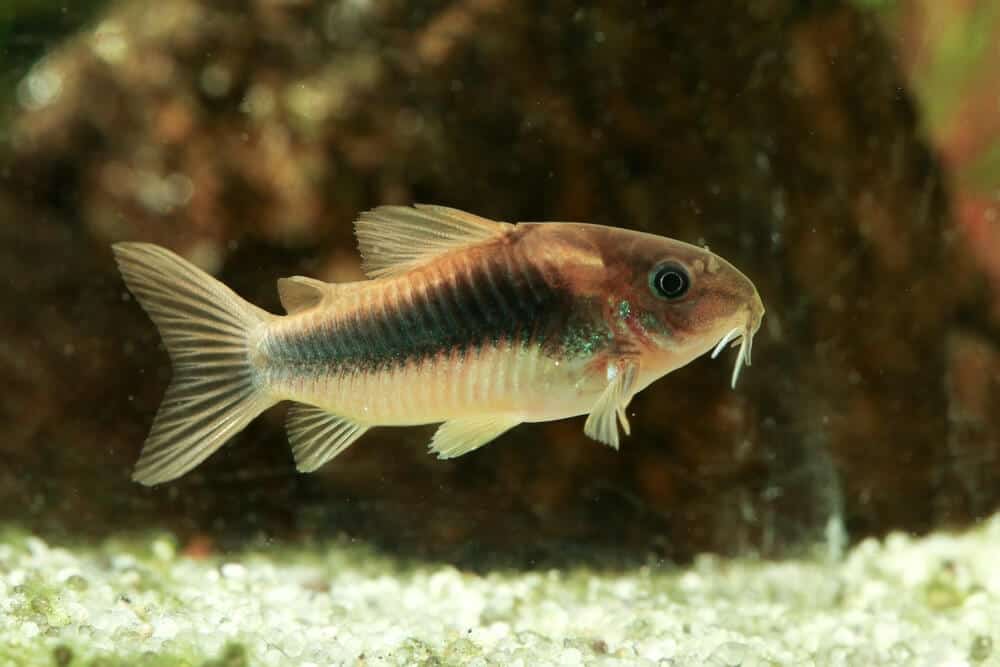
The Cory Catfish is a tropical freshwater fish that grows up to four inches long.
Their body is shaped like a torpedo with two large fins on the side of their head and a midline fin located right behind the eyes. The only other fins on the body are three small ones on each side of their tail fin.
This fish comes in a variety of colors, including silver, brown, and yellow with black spots. Some have white spots or stripes running through them, while others may not have any markings at all.
Cory Catfish are easy to care for. They are omnivorous, meaning they will eat both plants and animal matter.
Some may be found in schools while others prefer to live alone or in pairs. They are peaceful and will get along with other Firemouth Cichlid tank mates.
4. Rainbow Fish
Size: 2.5 to 6 inches
Minimum Tank Size: 15 to 30 gallons
Water Temperature Range: 73°F to 82°F
Diet: Omnivore
Care Requirements: Easy
Temperament: Peaceful

Rainbow fish are native to South America, Central America, and the Caribbean Sea but are most common in the Amazon River basin of Peru, Brazil, and Ecuador.
This species is a tropical fish that typically grows to about two to six inches in length. It has a long and slender body with a slightly depressed head.
It has beautiful colors ranging from brown and silver to blue, with bright stripes running through its body. The best way to tell if a rainbow fish is male or female is by looking at its colors.
Females often have bluish-green or turquoise colors, and males have bright red coloring. This wide range of colors is because they are genetically predisposed to have the ability to change their colors in response to environmental factors such as temperature or light level.
It also has a large mouth that can hold large amounts of food at a time. It is characterized by its long flowing fins used for swimming or jumping out of the water into air bubbles.
The Rainbow fish is a hardy fish that does not require a lot of space. It is relatively easy to care for and can be housed in most tanks, but they need special attention because they are prone to illness or disease.
It has a peaceful disposition, making it an ideal pet for beginners. The fish prefers to be kept in groups of three or more, but if you don’t have the room, then it’s okay to keep them separately.
In addition to being an excellent aquarium fish, the Rainbow fish will also eat prepared foods such as flake food, pellets, and vegetables.
5. Platy fish
Size: 3 inches
Minimum Tank Size: 10 gallons
Water Temperature Range: 70°F to 77°F
Diet: Omnivore
Care Requirements: Easy
Temperament: Peaceful
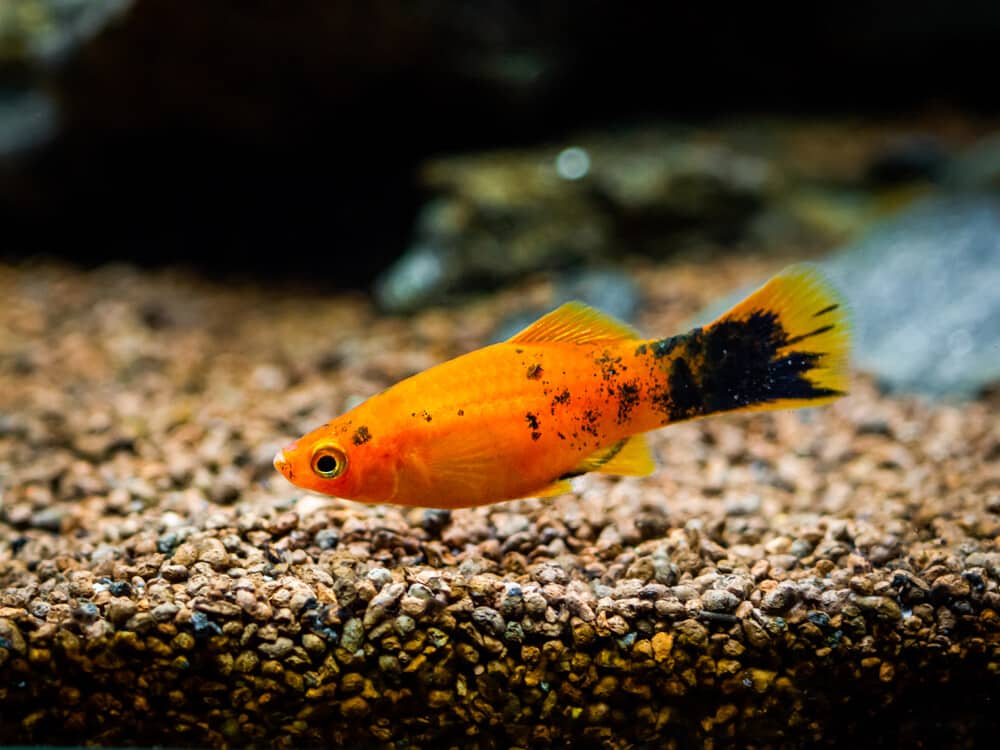
Platies can be found in freshwater streams and rivers throughout Central America, South America, and Asia.
The largest species is the Congolese Platy which grows to about three inches long. The smallest species is the Kribensis, which grows to about one inch.
The platy has a broad head with a pointed snout and large eyes. It also has a long dorsal fin with sharp spines running along its body length.
The coloration is variable, but the most common colors are red, silver, white, black, blue, and yellow.
They have a thick body that is covered in fine scales. The bottom fin is longer than the top fin, which makes it look like it has two fins.
Platies are a popular aquarium fish. They are usually a dwarf variety of scaleless pleco and one of the most popular freshwater aquarium fish.
Platies grow between two and three inches long, with males larger than females.
Platies can be found in many different habitats throughout their range. They include the flooded forests, rocky streams, rivers, and quiet lakes, where they spend most of their time hiding from predators under rocks or logs.
The platy’s personality is best described as shy. You will usually find it in the middle or back of the tank than at the front or sides.
However, it can be territorial towards other fish if they become too close to its territory.
6. Blue Acara
Size: 6 to 8 Inches
Minimum Tank Size: 30 gallons
Water Temperature Range: 72°F to 82°F
Diet: Omnivore
Care Requirements: Easy
Temperament: Peaceful
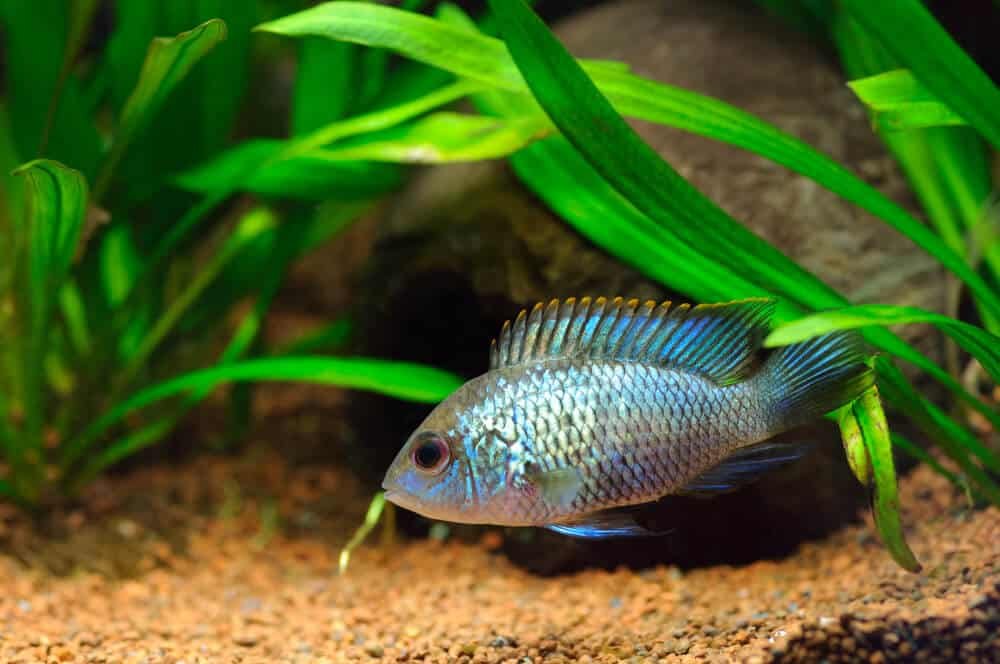
The Acara fish has a wide variety of colors, ranging from light golds to blue. The most common coloration is blue with black spots or streaks on the body or fins.
They also have yellow, orange, and red fins, which add to their beauty. The Acara fish has two long dorsal spines along its back and tail fin.
The dorsal spines can be retracted into the body if they become damaged or pulled on during playtime with other fish or when swimming fast through the water. Blue Acara is a popular pet fish because of its unusual coloring and personality.
They are very active and will swim around your tank almost constantly. This makes them suitable for people who have small tanks or don’t have much room in their house.
This fish is diurnal, which means it sleeps at night and moves around during the day. These fish are great for beginners to keep, as they are not very hard to care for.
Blue Acara fish can grow up to seven inches. They have a body covered with blue scales.
The male has a yellow tail and fins, while the female has a red tail and fins. Blue Acara fish have bright blue eyes, which are also very sensitive to light.
If you keep your Blue Acara fish in an aquarium with other types of fish, avoid keeping other types of brightly colored fish because their colors will compete for the same space on your tank walls and decorations.
7. Convict Cichlids
Size: 4 to 5 inches
Minimum Tank Size: 30 gallons
Water Temperature Range: 79°F to 84°F
Diet: Omnivore
Care Requirements: Easy
Temperament: Semi aggressive
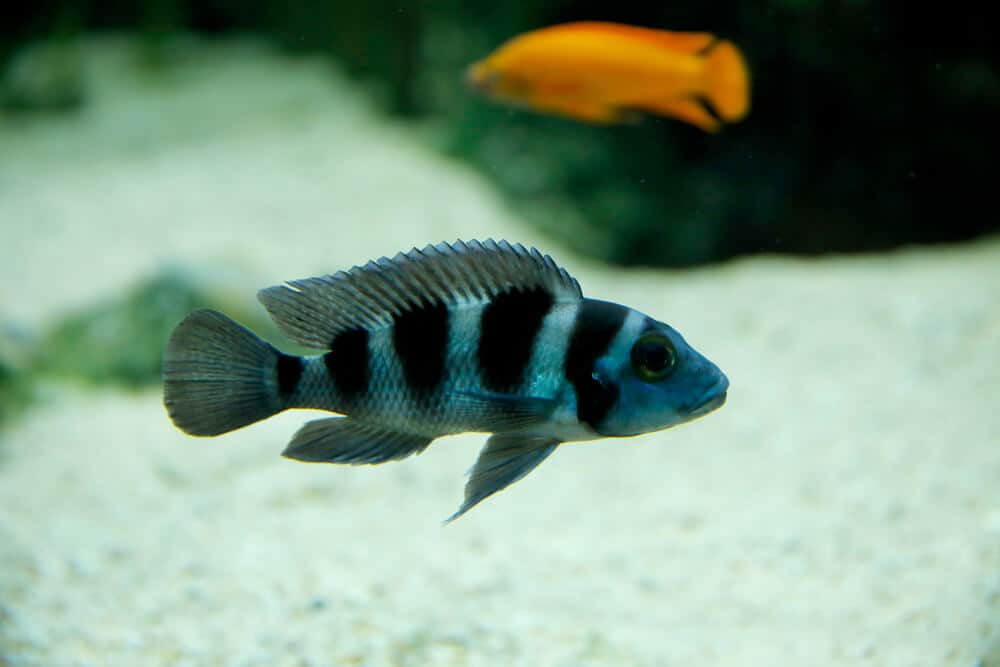
The Convict Cichlid has a slim body that tapers to a point, with a sharp-pointed snout that extends forward in an almost triangular shape. The males are usually larger than females, with a larger dorsal fin on their bodies.
Their body color is usually black with red or orange dots on the sides, but they can also be orange or yellow with black spots on their backs. These patterns aren’t always consistent from one individual to another.
The Convict Cichlid is an omnivore that will eat most foods and should be fed a varied diet, including vegetables, fruits, and live or frozen foods. They also require live foods such as brine shrimp, blood worms, and daphnia to thrive.
These fish are semi-aggressive, requiring plenty of mental stimulation to keep them happy, such as hiding places and caves to explore in their tank. They need a lot of space to be happy and will eat their own young if they feel threatened.
They should never be kept with other aggressive fish unless they all have similar personalities.
8. Rosy Barbs
Size: 2.5 to 6 inches
Minimum Tank Size: 30 gallons
Water Temperature Range: 68°F to 78°F
Diet: Omnivore
Care Requirements: Easy
Temperament: Semi aggressive
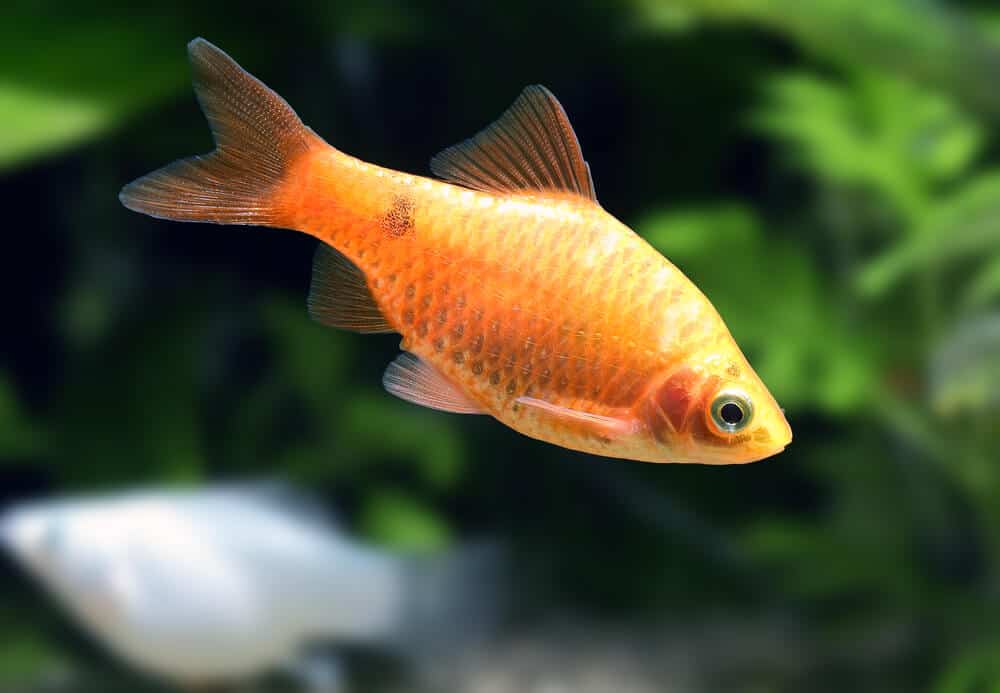
These small fish are often confused with other types of barbs, but they have a distinctive red or orange body coloration, which is why they’re called Rosy Barbs. They have bright red, orange, and yellow stripes on their bodies.
Their fins are white at the base with black tips, and the tail is bright orange or red. They may have some black specks on their tails, but these can fade over time.
They like a planted tank with plenty of rocks and hiding places to hide from their larger tank mates. Rosy Barbs are omnivorous and will eat just about anything you give them, including vegetables.
They are not picky eaters and eat just about anything they come across, including flake food, frozen bloodworms, and even insects. They will also enjoy sinking dried peas or brine shrimp.
These fish are a great choice for beginners because they are easy to care for, don’t require a lot of space, and can be easily fed.
Rosy Barbs are peaceful fish that get along well with most fish species in a community tank. They are not aggressive towards other fish but should be kept in groups of three or more, so they won’t feel threatened by other unfriendly fish.
If you plan on breeding these fish with other species, you must ensure they are raised in conditions that promote breeding: low lighting and temperatures between 68 to 78 degrees Fahrenheit.
More About The Firemouth Cichlid Fish Species
Size: 6 inches
Minimum Tank Size: 30 gallons
Temperament: Semi-aggressive
Diet: Omnivorous
Care Level: Easy
The Firemouth Cichlid is a freshwater fish bred in captivity for many years. It is very popular among aquarium enthusiasts because it is easy to care for and has a bright red coloration.
The Firemouth Cichlid is commonly found in the waters of Central America and South America, but it can also be found in many parts of Asia. This freshwater fish can grow up to two inches long and have been known to live up to five years in captivity.
Appearance
The Firemouth Cichlid is a fish that is native to South America. This fish has two distinct colors, with some being red and others being orange.
The color of this fish varies depending on where it is found. For example, the Firemouth Cichlid found in the Amazon River has a bright red body.
This fish has a long body shaped like a torpedo and a large mouth that opens widely. It can grow up to five to six inches in length.
They have large, reflective eyes, which helps them see at night or in dark waters with little light. The Firemouth Cichlid also has scales on its bodies, although these scales aren’t very big or noticeable.
The scales of this fish species are small and smooth, so they don’t cause any problems for humans when interacting with or touching it during breeding time.
Care Guidelines
The tank size for Firemouth Cichlids should be at least 55 gallons, with a minimum of 30 gallons being the best. The larger the tank, the better for these fish.
They are territorial and need room to swim around without bumping into other cichlids or being stunted by their own bodies.
Firemouth Cichlids need soft, acidic water with a pH of six to seven and a temperature of 75 to 82 degrees Fahrenheit (24-28°C). If you have hard water, you will need to work to keep it as soft as possible by adding salt mix or liquid chlorine to the water regularly (once every two weeks).
You can also add an air stone to help increase oxygenation in your tank by aerating the water. As far as what type of substrate goes in the tank with these cichlids, you can use anything from sand and gravel to plastic plants.
Firemouth Cichlids are susceptible to many diseases, including fin rot and ich. These diseases can be transmitted through water changes and should be avoided at all costs.
The best way to prevent these diseases is by using high-quality, filtered, or bottled water when maintaining your tank. Firemouths will eat almost any food offered to them.
They do not require much variety in their diets as long as there is a high proportion of meaty foods. Most fish stores carry frozen blood worms, brine shrimp, and other quality sources of protein that can be used to supplement an overall healthy diet.
They are peaceful when kept in groups. They are also playful, so you should expect them to spend most of their time swimming around your tank or the tank’s surface.
They will also constantly search for food, so if you don’t feed them often enough, they may become aggressive towards other fish in the tank.
Frequently Asked Questions About Firemouth Cichlids
How many Firemouth Cichlids should you keep together?
The minimum number of Firemouth Cichlids you can keep in a tank is six. The larger the tank, the more likely you will have to split your fish up.
What can live with Firemouth Cichlids?
Firemouth Cichlids are great with other fish, but they do best when they are kept in groups of six or more. They will tolerate other algae eaters, omnivores, and herbivores as long as they aren’t too aggressive.
What size tank does Firemouth Cichlid need?
As a rule of thumb, the bigger, the better for these fish, but they prefer at least a 30-gallon tank and taller tanks that are easier to clean and maintain. They also need a fairly open floor plan with plenty of caves and hiding places to use when they feel threatened by other fish in their group.
Are Firemouth Cichlids suitable for beginners?
Firemouth Cichlids are a popular choice among beginner fishkeepers. They also tend to be hardy and long-lived animals, making them excellent choices for beginners who want to build up their collections slowly.
Will Firemouths eat other fish?
Firemouth Cichlids are generally peaceful, except when spawning. During this season, they tend to become territorial and aggressive towards other fish and might harm or eat the other fish that cross the line.
Do Firemouth Cichlids thrive well with Oscars?
Yes, you can also add Oscars as tank mates for your Firemouths. Since they are closely similar to Convicts, the two species will thrive without conflict.
However, note that Oscars can grow as long as 20 inches. So adjust the tank size depending on how many you want to add.
For two Oscars, you will need a 75-gallon tank. Avoid overcrowding the tank to ensure the fish won’t injure or fight each other.
Conclusion
Ultimately, the size and temperament of your Firemouth Cichlid will determine which fish you should keep it with. If you choose to keep the species with a community of fish, be prepared to do frequent water changes and always have an escape-proof tank to avoid any nasty surprises.
With all of this information, you should be able to select some good Firemouth Cichlid tank mates. Whatever choices you make, remember that the key ingredient is patience.
All cichlids will have moments of aggression from time to time, but a gentle hand and plenty of time will help bring out the best in them.
